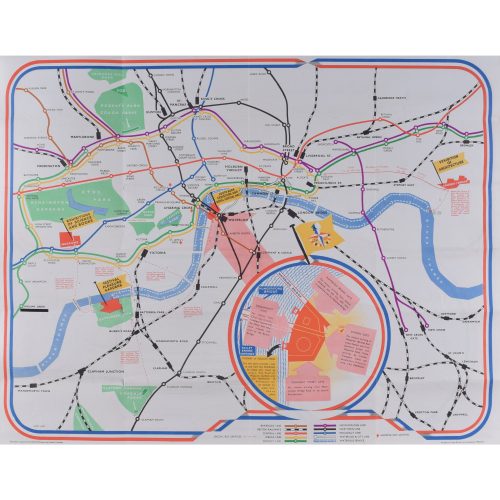-

Fred Taylor (1875-1963)
Hampton Court by Tram (1929)
Lithographic poster backed to linen 75 x 50 cm Published by Underground Electric Railways Company Ltd, 1929, printed by Vincent Brooks, Day & Son Ltd Click here for biographical details and other works by the artist. If you are interested email info@manningfineart.co.ukor call us on 07929 749056. -
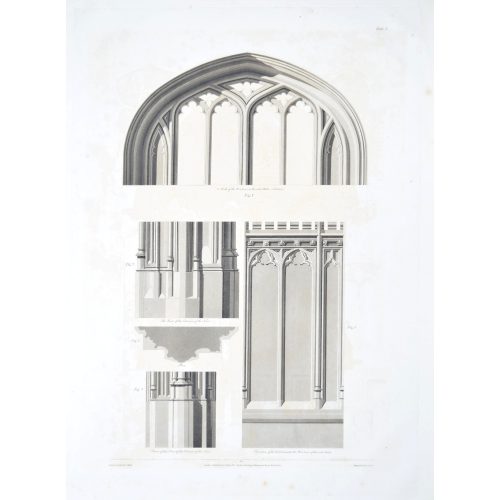
Frederick Nash (1782-1856) Drawn and etched Engraved by F C Lewis Arches and Columns
London Published by F Nash, No 6 Asylum Buildings, Westminster Road July 12 1804 55x39cm Frederick Nash was born in Lambeth. Initially studying architectural drawing under Thomas Malton he subsequently enrolled at the Royal Academy of Arts. From 1801 to 1809 he worked with the antiquarians John Britton and Edward Wedlake Brayley, subsequently becoming a member of the Society of Painters in Watercolours - a group of painters who had left the Royal Academy following complaints of under-recognition of their works. Latterly primarily a landscape painter he toured the rivers of Germany. If you are interested email info@manningfineart.co.uk or call us on 07929 749056. Condition: In generally good condition, some offsetting of ink from adjacent print as visible in image, occasional spotting. Not trimmed. -
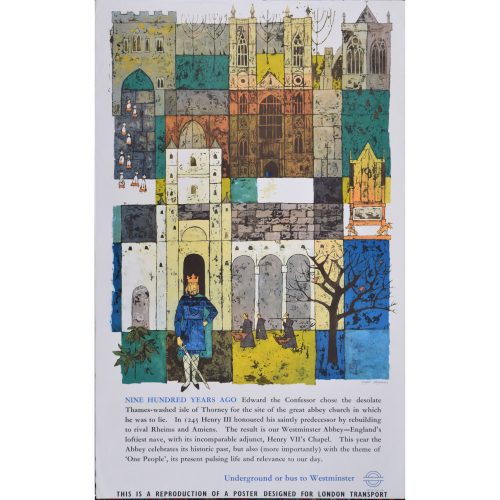
Gaynor Chapman (1935-2000)
Nine Hundred Years Ago
1966 Lithographic poster for London Transport From the original printing but sold at the time in the London Transport poster shop hence overprinted 'This is a reproduction of a poster designed for London Transport." 101×63.5cm Chapman attended the Epsom School of Art and the RCA where she studied illustration and graphics. Her posters for London Transport are amongst her best works. If you are interested email info@manningfineart.co.uk or call us on 07929 749056. -
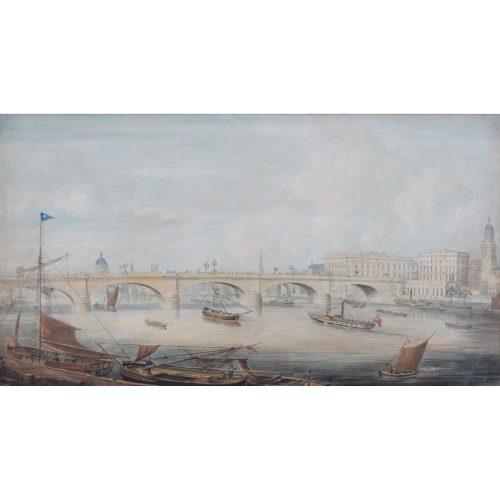
Gideon Yates (?1790-?1840)
1831 View on The Thames with London Bridge from the East Side showing Fishmonger's Hall, The Church of St Magnus the Martyr and St. Paul's Cathedral.
c.1831 29x54cm Watercolour unsigned Provenance: The Parker Gallery LIttle is known of the life of Yates. Even his date of death is disputed with some sources putting it at 1837. What is known is that he spent most of his working life in London, producing many detailed views of The Thames such as this one. His style is very distinctive, and this large and impressive view of London Bridge is a typical view. He is thought to have lived in Lancaster in 1811, and to have travelled widely throughout Britain and the Continent. His works are in public collections including the Victoria and Albert Museum. In this view, Thames barges are in the foreground with their distinctive brown sails. A steamship proceeds along the middle of The Thames. The first steamboat patented was in 1729, by John Allen an English physician. However it was not until 1783 that the first steam-powered ship, "Pyroscaphe," was demonstrated on the River Saône. By 1788 John Fitch in Philadelphia was operating a commercial service along the Delaware River were built in the United States. The first sea-going steamboat was the "Experiment" built by Richard Wright in 1813; by this point river services were becoming well established although it was not until 1815 that The Thames acquired its first successful services with "Margery" and "Thames" arriving from the Clyde where they had been in service for some years. Margate and Gravesend were the main destinations. The steamboat in this view is a paddlesteamer, with two side wheels. At the north end of London Bridge (on the far side from the viewer) is Fishmongers' Hall, St Magnus the Martyr Church is visible on the near side of the bridge, and St Paul's Cathedral is visible beyond. UK Government Art Collection item 6701 is another view of The Thames by Yates, also from The Parker Gallery. If you are interested email info@manningfineart.co.uk or call us on 07929 749056. -
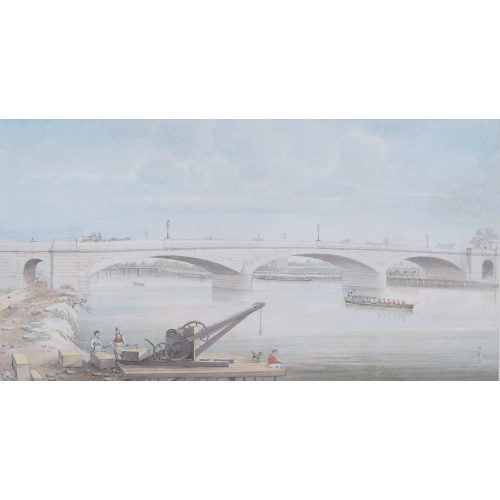
Gideon Yates
View on The Thames with Staines Bridge
25 x 48 cm Watercolour Charmingly signed lower left, on the side of the stone c.1830 Little is known of the life of Yates. Even his date of death is disputed with some sources putting it at 1837. What is known is that he spent most of his working life in London, producing many detailed views of The Thames such as this one. His style is very distinctive, and this large and impressive view of London Bridge is a typical view. He is thought to have lived in Lancaster in 1811, and to have travelled widely throughout Britain and the Continent. His works are in public collections including the Victoria and Albert Museum. UK Government Art Collection item 6701 is another view of The Thames by Yates. Click here for other paintings by Yates. If you are interested email info@manningfineart.co.uk or call us on 07929 749056. -
Out of stock
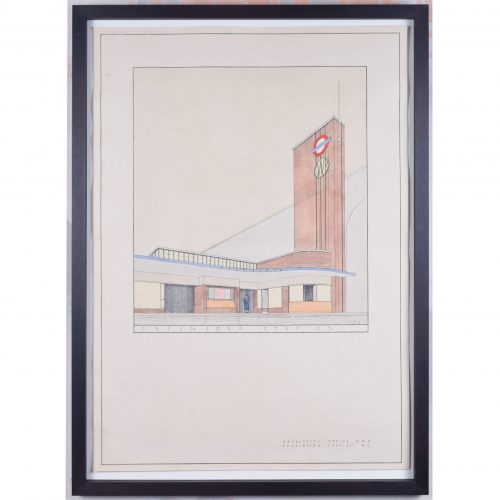
Brian Bannatyne Lewis (1906 - 1991)
Greenford Station (1938)
Pen, ink and watercolour 70 x 50 cm Initialled and dated 7 3 38. A 1938 design for the new Greenford tube station, commissioned by the Great Western Railway (GWR) for its proposed western extension to the Central Line. The design's Art Deco lettering befits London Transport's aesthetic in the 1930s. Lewis brings his designs to life by including smartly-dressed characters entering and leaving the stations. The Central line opened in 1900, between Shepherd's Bush and Bank; it extended westwards to Ealing Broadway in 1920. Two years after the formation of London Transport in 1933, an extensive New Works Programme began, proposing a westwards extension of the line to Denham. Brian Lewis created designs for nine stations in early 1938, but the Second World War broke out before they could be built. By the time the extension had been built, Lewis was no longer chief architect of the GWR - the stations were modified and completed by Frederick Francis Charles Curtis instead. The extension to Greenford opened in 1947 and finally reached West Ruislip in 1948. Denham never actually became part of the tube line, owing to the establishment of the green belt. Brian Lewis was born in Tasmania, attended school in Melbourne, and subsequently obtained a Diploma in Architecture in 1928 from the University of Melbourne. He then moved to the UK to study at the Liverpool School of Architecture, winning scholarships in each of his three years of study to fund extensive European travel. He married a fellow Liverpool architectural student, Hilary Archer. After moving to London, he took up employment with the GWR in their architects’ office; he also lectured at a local polytechnic, and moonlighted with his wife at home on mainly residential commissions – rather different projects from the hotels and stations which GWR commissioned from him. He exhibited frequently at the Royal Academy of Arts, showing superb measured drawings of historic buildings. In the Second World War he enlisted with the Second Imperial Australian Force, serving in the Middle East, then transferred to the Royal Australian Engineers where he became a Captain. In 1943 he was sent to London to help GWR repair bomb damage. Lewis became Chief Architect of GWR in 1945 (following the retirement of the noted Percy Emerson Culverhouse), and the first Chair of Architecture at Melbourne University in 1947. He also became the consulting architect for the major buildings of the Australian National University in Canberra, producing an imaginative site plan and designing University House, which was awarded the Sulman medal in 1954. He also designed the Risdon Prison Complex in 1960. He retired in 1971 to paint watercolours and write his memoirs. Condition: generally very good; a few handling marks and two holes from filing. Handsomely framed. If you are interested, please email info@manningfineart.co.uk or call us on 07929 749056. Click here to view the other station designs in the set. -
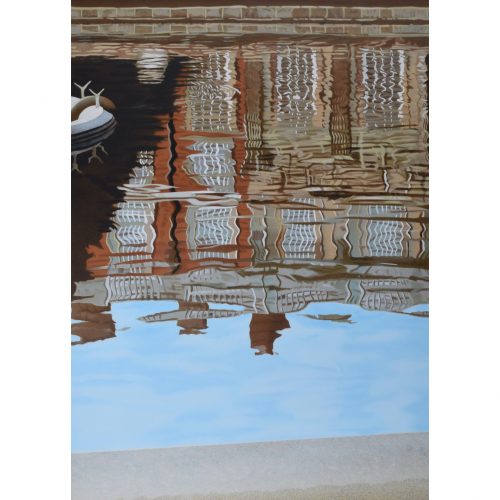
Brendan Neiland (b.1941) R.A. (Expelled)
Hampton Court (1984)
Screenprint 74 x 51 cm Signed, dated, titled, and numbered 152/250 in pencil. A print of one of Hampton Court's magnificent facades, reflected in its fountain. Reflected architecture is one of Neiland's most recurring themes. The Fountain Court was designed by Sir Christopher Wren; he began remodelled the palace in the baroque style for William III and Mary II in 1689. It held private and state apartments for both the King and Queen. Wren’s other works at Hampton Court Palace include the Lower Orangery and the grand colonnade in Clock Court, providing a grand entrance to the King's Apartments. The architectural historian Sir John Summerson described Fountain Court as 'Startling, as of simultaneous exposure to a great many eyes with raised eyebrows'. Brendan Neiland (born 23 October 1941 in Lichfield, Staffordshire) is an English artist best known for his paintings of reflections in modern city buildings. In 1992 he was elected to the Royal Academy (RA). Neiland is known for his interpretations of city life. His work is widely exhibited in major museums and galleries worldwide including, in Britain, the Victoria and Albert Museum, The Tate Gallery London, The Collections of the British Council and the Arts Council of Great Britain. He is represented by the Redfern Gallery and has had numerous shows internationally, including at the Galerie Belvedere in Singapore, who represent him in Singapore and the Far East. Condition: very good. If you’d like to know more, please email info@manningfineart.co.uk or call us on 07929 749056. -
Out of stock
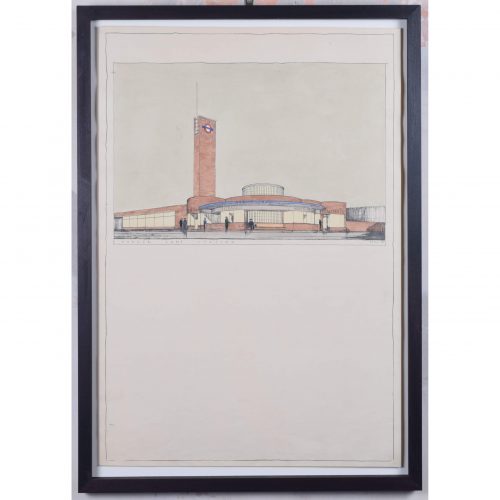
Brian Bannatyne Lewis (1906 - 1991)
Hanger Lane Station (1938)
Pen, ink and watercolour 70 x 50 cm Inscribed 'BB Lewis' lower right. A 1938 design for the new Hanger Lane tube station, commissioned by the Great Western Railway (GWR) for its proposed western extension to the Central Line. The design's Art Deco lettering befits London Transport's aesthetic in the 1930s. Lewis brings his designs to life by including smartly-dressed characters entering and leaving the stations. The Central line opened in 1900, between Shepherd's Bush and Bank; it extended westwards to Ealing Broadway in 1920. Two years after the formation of London Transport in 1933, an extensive New Works Programme began, proposing a westwards extension of the line to Denham. Brian Lewis created designs for nine stations in early 1938, but the Second World War broke out before they could be built. By the time the extension had been built, Lewis was no longer chief architect of the GWR - the stations were modified and completed by Frederick Francis Charles Curtis instead. The extension to Greenford opened in 1947 and finally reached West Ruislip in 1948. Denham never actually became part of the tube line, owing to the establishment of the green belt. Brian Lewis was born in Tasmania, attended school in Melbourne, and subsequently obtained a Diploma in Architecture in 1928 from the University of Melbourne. He then moved to the UK to study at the Liverpool School of Architecture, winning scholarships in each of his three years of study to fund extensive European travel. He married a fellow Liverpool architectural student, Hilary Archer. After moving to London, he took up employment with the GWR in their architects’ office; he also lectured at a local polytechnic, and moonlighted with his wife at home on mainly residential commissions – rather different projects from the hotels and stations which GWR commissioned from him. He exhibited frequently at the Royal Academy of Arts, showing superb measured drawings of historic buildings. In the Second World War he enlisted with the Second Imperial Australian Force, serving in the Middle East, then transferred to the Royal Australian Engineers where he became a Captain. In 1943 he was sent to London to help GWR repair bomb damage. Lewis became Chief Architect of GWR in 1945 (following the retirement of the noted Percy Emerson Culverhouse), and the first Chair of Architecture at Melbourne University in 1947. He also became the consulting architect for the major buildings of the Australian National University in Canberra, producing an imaginative site plan and designing University House, which was awarded the Sulman medal in 1954. He also designed the Risdon Prison Complex in 1960. He retired in 1971 to paint watercolours and write his memoirs. Condition: generally very good; a few handling marks and two holes from filing. Handsomely framed. If you are interested, please email info@manningfineart.co.uk or call us on 07929 749056. Click here to view the other station designs in the set. -
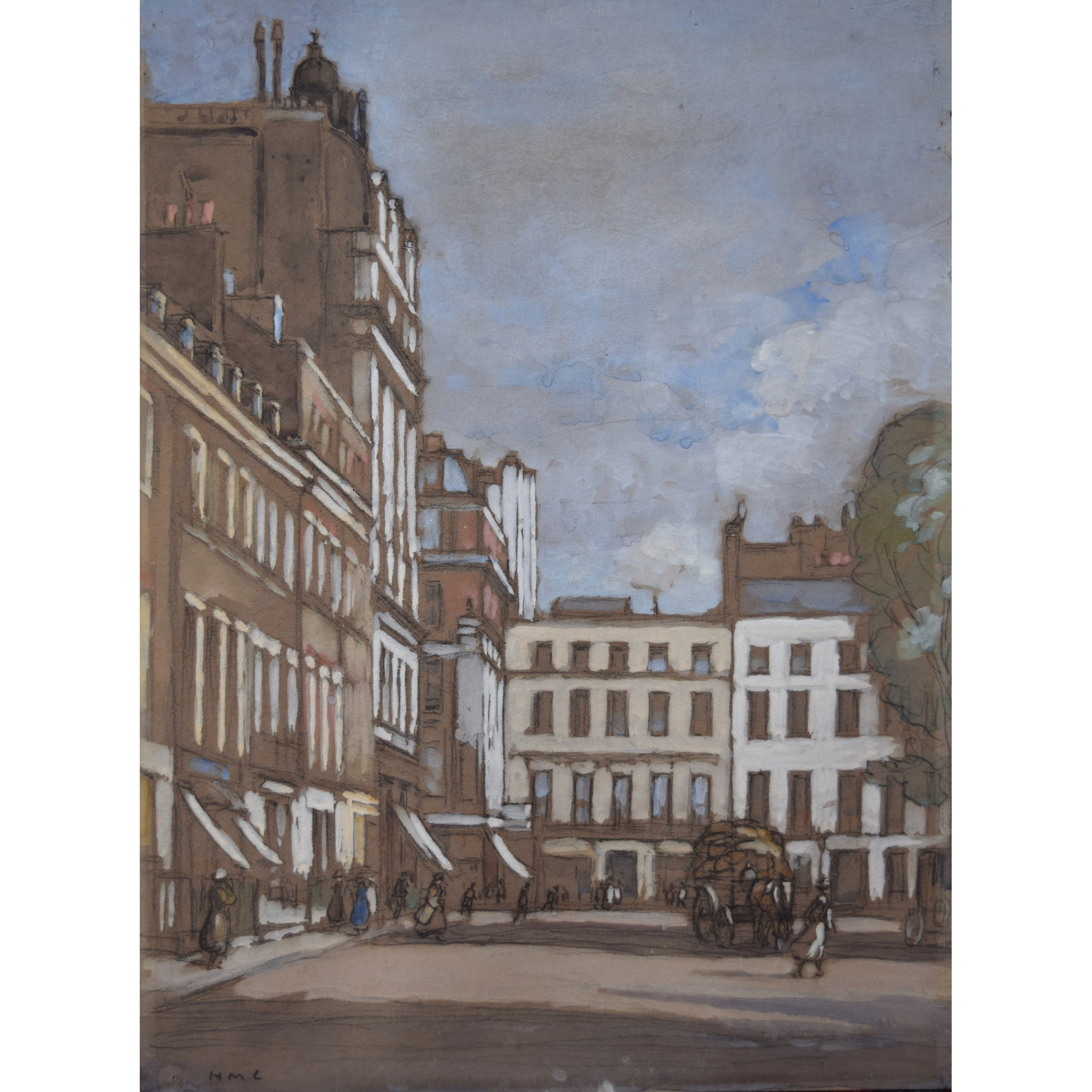
Horace Mann Livens (1862-1936)
Hanover Square London (1920)
Gouache on paper 37x27 cm For biographical details and other works by Livens click here. If you are interested email info@manningfineart.co.uk or call us on 07929 749056. -
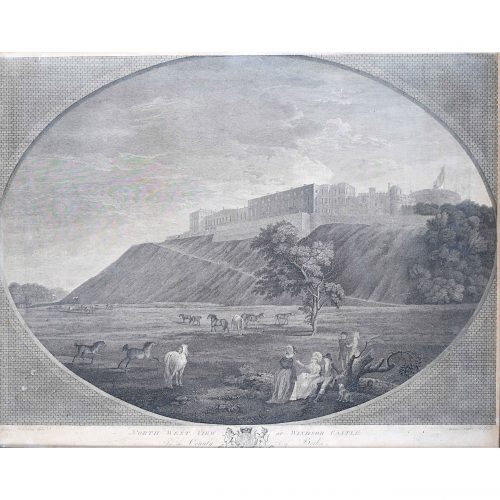
James Fittler (1758-1835) after George Robertson (1748-1788)
North West View of Windsor Castle in the County of Berks (1782)
47x58cm London: Published by John Boydell Fittler engraved two views of Windsor by Robertson. Trained at Royal Academy Schools, he was a skilled engraver and etcher and joined the mid-18th century trend for recording the landscape of the British Isles, producing and selling prints to tourists. A copy of this print is in the National Trust's collection at Anglesea Abbey, from Lord Fairhaven's extraordinary collection of views of Windsor Castle. -
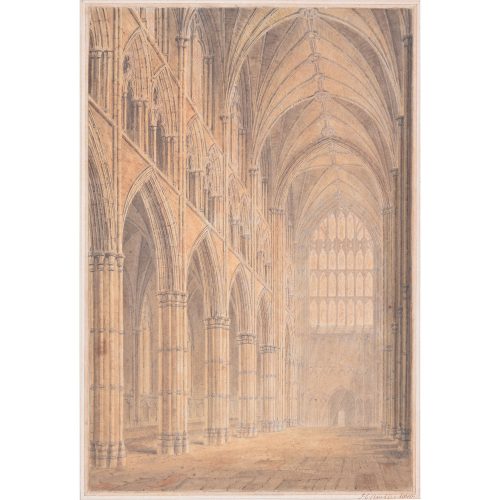
John Chessel Buckler (1793-1894)
The Nave of Westminster Abbey
Watercolour Signed, Titled and dated 1810 25x17 cm Click here for other works by Buckler and biographical detail. If you are interested email info@manningfineart.co.uk or call us on 07929 749056. -
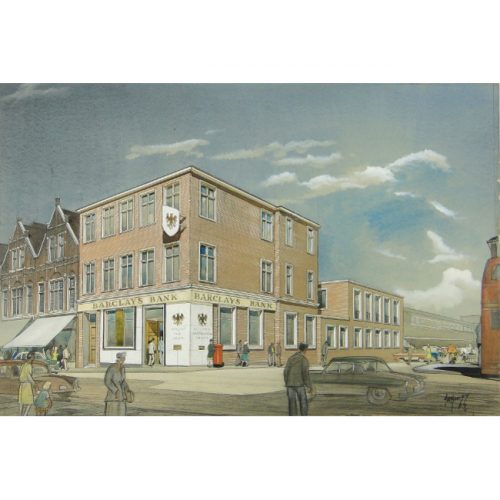
John Dean Monroe Harvey (1895-1978)
A design for Barclays Bank, Walthamstow (1964)
Signed and dated ‘J D M Harvey 64.’ Gouache on paper. A very fine architectural perspective by Harvey with his customary distinctive clouds and elegant people. The scheme was built, but the ground floor has since been rebuilt in a rather less satisfactory fashion. 41 x 60 cm (16 x 23 inches) For biographical details and more works by JDM Harvey, please click here. If you are interested email info@manningfineart.co.uk or call us on 07929 749056. -
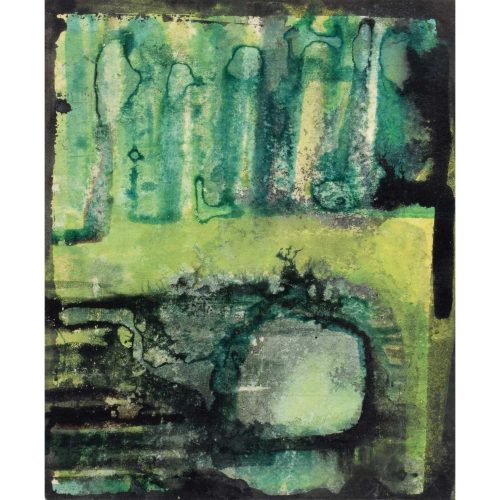
John Piper (1903-1992)
Study for the Piper Building mural
Gouache 14.5x11.5cm Provenance: P Manzareli (who built the fibreglass murals for Piper), gift from the artist; Milne & Moller Fine Art; Katharine House Gallery; private collection, Scotland. This study is a fascinating part of London's architectural history. The Piper Building is a mid-century architectural icon in Fulham. Built in the 1950s as 'Watson House', it was a laboratory complex for the North Thames Gas Board and has an innovative concrete structure. Piper was commissioned to produce the murals surrounding the building. The Gas Board moved out in the mid 1980s. Scheduled for demolition in the 1990s, the building was instead converted into seventy apartments and renamed the Piper Building. With double-height ceilings, the apartments were sold as shells, and purchasers were free to commission their own architects and builders. Condition: Generally excellent; framed. For other works by the artist and biographical details, click here. If you are interested email info@manningfineart.co.uk or call us on 07929 749056. -
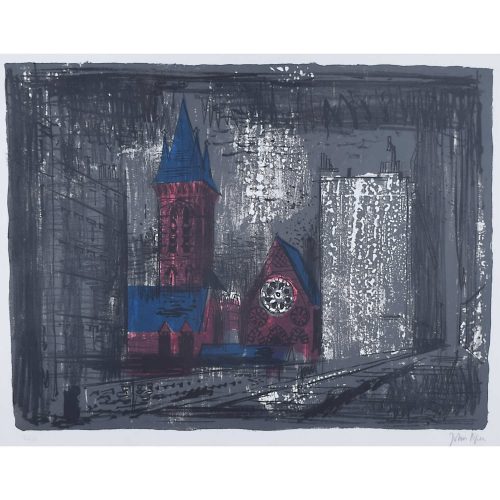
John Piper (1903-1992)
St James the Less, Westminster
Screenprint 65 x 49 cm From the 'Retrospect of Churches' series, numbered 24/70. Generally very good. Signed in pencil. John Piper CH was an English painter, printmaker, and designer of stained-glass windows. His work often focused on the British landscape, especially churches and monuments, and included tapestry designs, book jackets, screen-prints, photography, fabrics and ceramics. A Retrospect of Churches was issued as a suite of 24 original colour lithographs in colour, in an edition of 70 copies (70 numbered copies plus five artist's proofs). This poignant and dramatic representation of St James the Less is an evocative depiction of this part of London in the evening: wet pavements reflect the bright lights of the buildings, and the church is a warm, moody reddish-purple against the deep black of a dark night. Condition: Generally very good. -

Julian Trevelyan (1910-1988)
Father Thames (1969)
Etching and aquatint, signed, numbered 53/75 35x48cm Click here for biographical details and other works by the artist. If you are interested email info@manningfineart.co.uk or call us on 07929 749056.

